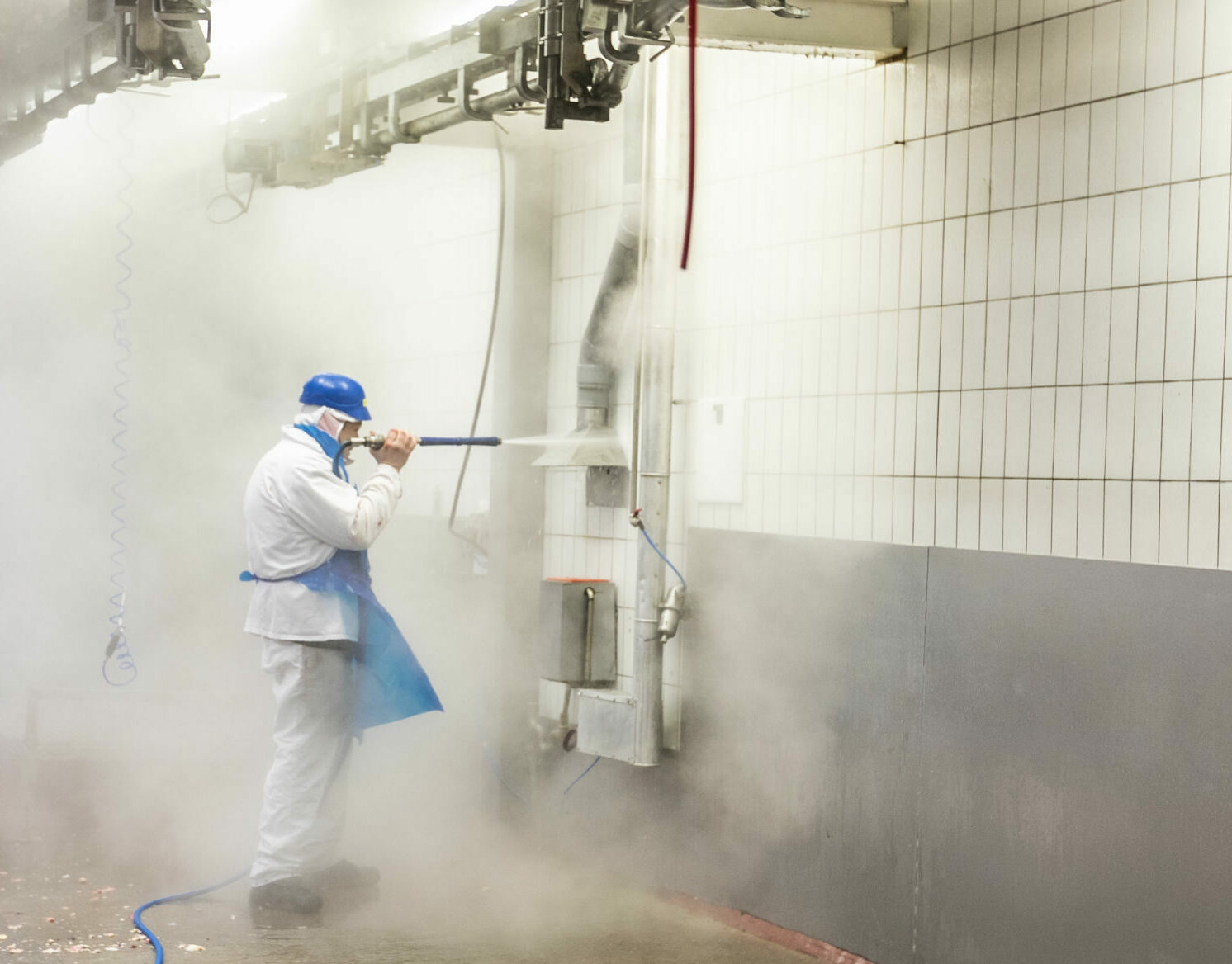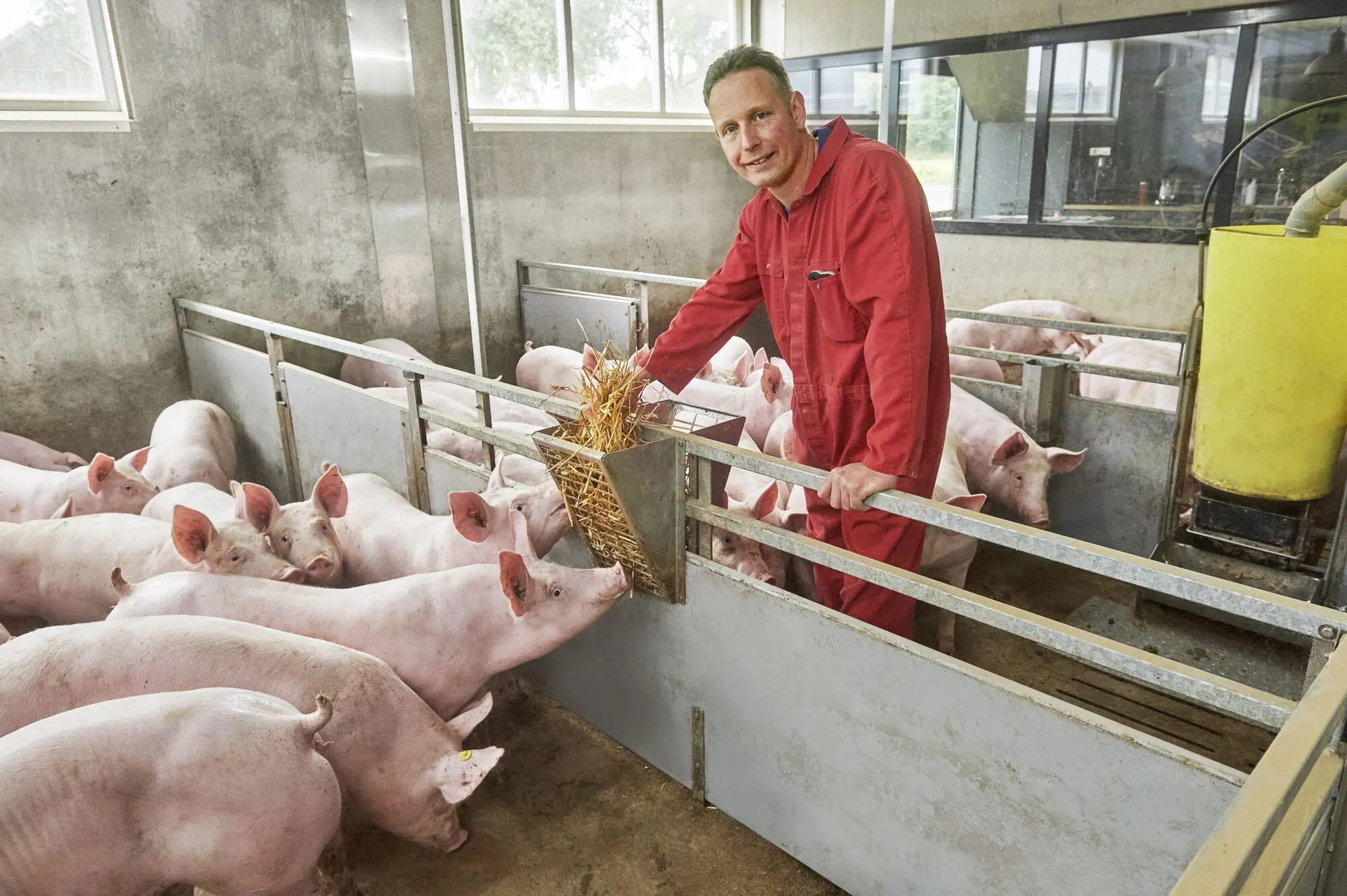
Inspection results cattle
Live inspection upon arrival at abattoir
When the cattle arrive at the slaughterhouse, each animal is individually inspected by an official veterinarian. Particular attention is paid to the evaluation of the transport conditions, animal health and the animal’s wellbeing. Only animals that do not show any signs of a condition that may affect the health of humans or animals may be slaughtered. If there are reasonable doubts about the condition of an animal, the veterinarian will carry out a more detailed examination and then decide whether the animal can be approved for slaughter for the production of food or not.
Live inspection
Cattle per quarter
Without findings
With findings
Without findings
With findings
Without findings
With findings
37.461 cattle per quarter
Directly approved at live inspection
Remarks during live inspection
31.097 cattle per quarter
Directly approved at live inspection
Remarks during live inspection
43.097 cattle per quarter
Without findings
With findings
31.976 cattle per quarter
Directly approved at live inspection
Remarks during live inspection
Without findings
With findings
36.485 cattle per quarter
Directly approved at live inspection
Remarks during live inspection
Without findings
With findings
36.289 cattle per quarter
Directly approved at live inspection
Remarks during live inspection
Without findings
With findings
33.054 cattle per quarter
Directly approved at live inspection
Remarks during live inspection
Without findings
With findings
33.054 cattle per quarter
Directly approved at live inspection
Remarks during live inspection
35.635 cattle per quarter
Directly approved at live inspection
Remarks during live inspection
Without findings
With findings
33.914 cattle per quarter
Directly approved at live inspection
Remarks during live inspection
Without findings
With findings
26.996 cattle per quarter
Directly approved at live inspection
Remarks during live inspection
Without findings
With findings
34.502 cattle per quarter
Directly approved at live inspection
Remarks during live inspection
Without findings
With findings
24.962 cattle per quarter
Directly approved at live inspection
Remarks during live inspection
Without findings
With findings
24.962 cattle per quarter
Directly approved at live inspection
Remarks during live inspection
Without findings
With findings
Without findings
With findings
20.857 cattle per quarter
Directly approved at live inspection
Remarks during live inspection
Without findings
With findings
29.819 cattle per quarter
Directly approved at live inspection
Remarks during live inspection
Without findings
With findings
39.434 cattle per quarter
Directly approved at live inspection
Remarks during live inspection
Without findings
With findings
32.590 cattle per quarter
Directly approved at live inspection
Remarks during live inspection
Without findings
With findings
This filter options do not have any results. Please adjust the filters to get some results
The graphic “Official ante-mortem inspection” shows the results of the decision of the official veterinarian regarding the inspection of the individual animals:
Directly approved at live inspection: Proportion of cattle that have been directly been approved for slaughter for the production of food
Remarks during live inspection: Proportion of cattle that have remarks during live inspection and are not immediately approved for slaughter
Cattle delivered
Percentage of cattle killed during transportation
Cattle delivered
Death on arrival
Cattle delivered
Death on arrival
Cattle delivered
Death on arrival
Cattle delivered
death on arrival
Cattle delivered
death on arrival
Cattle delivered
death on arrival
Cattle delivered
death on arrival
Cattle delivered
death on arrival
Cattle delivered
death on arrival
Cattle delivered
death on arrival
Cattle delivered
death on arrival
Cattle delivered
death on arrival
Cattle delivered
death on arrival
Cattle delivered
death on arrival
Cattle delivered
death on arrival
Cattle delivered
death on arrival
Cattle delivered
death on arrival
Cattle delivered
death on arrival
Cattle delivered
death on arrival
Cattle delivered
death on arrival
Cattle delivered
death on arrival
This filter options do not have any results. Please adjust the filters to get some results
Food safety
After inspecting live animals, the meat of each carcass is inspected during the slaughtering process. Inspectors and veterinarians from public authorities carry out this inspection. All parts of the animals are carefully inspected. Only meat that is absolutely safe is approved. Here, too, any reason for doubt means that extra examinations are carried out by public authorities.
The inspection results of the meat inspection (food safety) are summarized in the graph below.
Official meat inspection cattle - food safety
Approved
Not approved (not suitable for consumption)
Approved
Not approved (not suitable for consumption)
Approved
Not approved (not suitable for consumption)
Approved
Not approved (not suitable for consumption)
Approved
Not approved (not suitable for consumption)
Approved
Not approved (not suitable for consumption)
Approved
Not approved (not suitable for consumption)
Approved
Not approved (not suitable for consumption)
Approved
Not approved (not suitable for consumption)
Approved
Not approved (not suitable for consumption)
Approved
Not approved (not suitable for consumption)
Approved
Not approved (not suitable for consumption)
Approved
Not approved (not suitable for consumption)
Approved
Not approved (not suitable for consumption)
Approved
Not approved (not suitable for consumption)
Approved
Not approved (not suitable for consumption)
Approved
Not approved (not suitable for consumption)
Approved
Not approved (not suitable for consumption)
Approved
Not approved (not suitable for consumption)
Approved
Not approved (not suitable for consumption)
Approved
Not approved (not suitable for consumption)
Approved
Not approved (not suitable for consumption)
Approved
Not approved (not suitable for consumption)
Approved
Not approved (not suitable for consumption)
Approved
Not approved (not suitable for consumption)
Approved
Not approved (not suitable for consumption)
Approved
Not approved (not suitable for consumption)
Approved
Not approved (not suitable for consumption)
Approved
Not approved (not suitable for consumption)
Approved
Not approved (not suitable for consumption)
Approved
Not approved (not suitable for consumption)
Approved
Not approved (not suitable for consumption)
Approved
Not approved (not suitable for consumption)
Approved
Not approved (not suitable for consumption)
Approved
Not approved (not suitable for consumption)
Approved
Not approved (not suitable for consumption)
Approved
Not approved (not suitable for consumption)
This filter options do not have any results. Please adjust the filters to get some results
Approved: the carcass of the cattle has been assessed as suitable for human consumption
Not approved: the carcass of the cattle has been judged not to be suitable for human consumption
Organ findings
During the official meat inspection, in addition to the inspection of the carcass, all organs of a cattle are also examined by official veterinarians and specialist assistants. Only organs that are safe for human consumption are allowed for further processing. The carcass and organs provide information about the animal health status of an entire herd. Findings are saved for each individual animal and reported back to the farm. With this information, the farmer can make decisions about the animal health management of his livestock.
The inspection results of the meat inspection (food safety) are summarized in the graph below. In the archive you will find the inspection results of the previous quarters and years.
Official meat inspection cattle - organ findings
Without findings
With findings
Without findings
With findings
Without findings
With findings
Without findings
With findings
1.740.011 pigs per quarter
Without findings
With findings
Without findings
With findings
Without findings
With findings
Without findings
With findings
Without findings
With findings
Without findings
With findings
Without findings
With findings
Without findings
With findings
Without findings
With findings
Without findings
With findings
Without findings
With findings
Without findings
With findings
Without findings
With findings
Without findings
With findings
Without findings
With findings
Without findings
With findings
Without findings
With findings
Without findings
With findings
Without findings
With findings
Without findings
With findings
Without findings
With findings
Without findings
With findings
Without findings
With findings
Without findings
With findings
Without findings
With findings
Without findings
With findings
Without findings
With findings
Without findings
With findings
Without findings
With findings
Without findings
With findings
Without findings
With findings
Without findings
With findings
Without findings
With findings
Without findings
With findings
Without findings
With findings
This filter options do not have any results. Please adjust the filters to get some results
Left graphic:
No findings: No findings could be found on the carcass and organs of a cattle.
With findings: One or more findings could be made on the carcass and / or the organs of a cow.
Right graphic:
Proportions of cattle with findings of which:
Liver: Findings in the liver can indicate metabolic changes, infections, parasitic infestation, an ingested foreign body or tumors.
Lungs, pleura, pericardium, heart: Findings on these organs indicate the presence of an inflammatory process.
Joint: Findings here provide evidence of inflammation of the joints during rearing
Abscess: An abscess is an encapsulated collection of pus that can arise after localized bacterial inflammation.
Bowel: A finding indicates inflammation of the bowel. This can be caused by a nutritional disorder, parasitic or another infection.
Parasites: indication of an infestation with sarcosporidia and / or fins.
Kidney: Findings suggest an infection of the kidney or the presence of another inflammatory process.
Antibiotics
The use of pharmaceuticals in animal husbandry is strictly regulated and may only take place after a thorough diagnosis and prescription by a veterinarian. After medication has been administered, statutory waiting times must be observed before a pig can be slaughtered for food production. The use of the medicinal product must be documented in detail by the farmer. Compliance with the rules is checked with official residue examinations at the slaughterhouse.
An official control program specifically focuses on checking the presence of antibiotic residues in meat. 0.5% of all slaughtered pigs undergo an official examination for antibiotic residues.
Inspection results: antibiotics (Germany)
2.747 inspected cattle per year
Without findings
With findings
2.747 inspected cattle per year
Without findings
With findings
2.473 inspected cattle per year
Without findings
With findings
1.403 inspected cattle per year
Without findings
With findings
3.470 inspected cattle per year
Without findings
With findings
This filter options do not have any results. Please adjust the filters to get some results
Without findings: no evidence of antibiotic residues
With findings: exceeding the legal limit values for antibiotic residues
National residue control plan 2021
As part of the annual national residue control plan, the official veterinarian carries out further examinations at the slaughterhouse. Meat and organs are examined for drug residues as well as undesirable and prohibited substances using targeted random samples. The individual substances to be examined can be found here.
The frequency and the substances to be examined are specified within the framework of a nationwide program that is coordinated by the Federal Office for Consumer Protection and Food Safety (national residue control plan). Every 2000th pig slaughtered is examined within the framework of this national residue control plan. More information on the national residue control plan.
Inspection results: national residue control plan
1.786 inspected cattle per year
Without findings
With findings
1.500 inspected cattle per year
Without findings
With findings
775 inspected cattle per year
Without findings
With findings
1.728 inspected cattle per year
Without findings
With findings
This filter options do not have any results. Please adjust the filters to get some results
Without findings: no evidence of drugs or undesirable substances
With findings: exceeding the legal limit value for drugs and/or undesirable and/or prohibited substances









